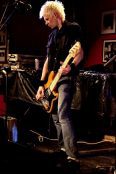Can science predict a hit song?
Most people remember listening to the official UK top 40 singles chart and watching the countdown on Top of the Pops, but can science work out which songs are more likely to 'make it' in the chart? New research has looked at whether a song can be predicted to be a 'hit'.
The paper, to be presented at an international workshop this week, argues that predicting the popularity of a song may well be feasible by using state-of-the-art machine learning algorithms. The research team, led by Dr Tijl de Bie, is based in the University of Bristol's Intelligent Systems Laboratory in the Faculty of Engineering.
The team looked at the official UK top 40 singles chart over the past 50 years. Their aim was to distinguish the most popular (peak position top five) songs from less popular singles (peak position 30 to 40).
The researchers used musical features such as, tempo, time signature, song duration and loudness. They also computed more detailed summaries of the songs such as harmonic simplicity, how simple the chord sequence is, and non-harmonicity, how 'noisy' the song is.
A 'hit potential equation' that scores a song according to its audio features was devised. The equation works by looking at all the UK hits for a certain time and measuring their audio features. From this the researchers had a list of weights, telling then how important each of the 23 features was and allowing them to compute a score for a song.
The team found they could classify a song into a 'hit' or 'not hit' based on its score, with an accuracy rate of 60 per cent as to whether a song will make it to top five, or if it will never reach above position 30 on the UK top 40 singles chart.
The study found some interesting trends, such as:
Before the eighties, the danceability of a song was not very relevant to its hit potential. From then on, danceable songs were more likely to become a hit. Also the average danceability of all songs on the charts suddenly increased in the late seventies.
In the eighties slower musical styles (tempo 70-89 beats per minute), such as ballads, were more likely to become a hit.
The prediction accuracy of the researchers' hit potential equation varies over time. It was particularly difficult to predict hits around 1980. The equation performed best in the first half of the nineties and from the year 2000. This suggests that the late seventies and early eighties were particularly creative and innovative periods of pop music.
Up until the early nineties, hits were typically harmonically simpler than other songs of the era. On the other hand, from the nineties onward hits more commonly have simpler, binary, rhythms such as 4/4 time.
On average all songs on the chart are becoming louder. Additionally, the hits are relatively louder than the songs that dangle at the bottom of the charts, reflected by a strong weight for the loudness feature.
Source: University of Bristol

The aim of art is to represent not the outward appearance of things, but their inward significance. – Aristotle














